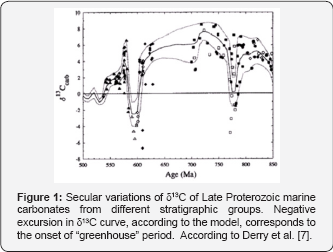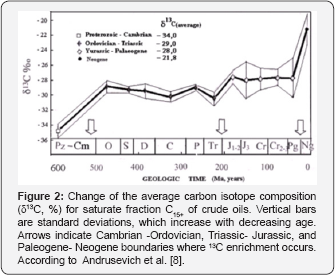Some Evidences on the Relationship of Cyclic Development of Photosynthesis and the Earth's Crust Processes- Juniper Publishers
Juniper Publishers- Journal of Oceanography


Abstract
According to the model of the global redox carbon cycle, there is a relationship between non-uniform movement of lithospheric plates and orogenic cycles of photosynthesis and climatic cycles. Some natural facts are given in favor of this assumption.
Keywords: Lithospheric plates' movement; Photosynthesis; Cycles; Organic carbon; Carbonates
Mini Review
Recently published model of the global redox carbon cycle [1] asserts that cycle is a recurring sequence of related processes on the Earth. The sequence is called the orogenic cycle and consists of short-term orogenic and long-term geosynclynal periods. The orogenic period of the cycle is characterized with intense volcanism, magmatism and mountain building. The geosynclynal period is characterized with quiet development of the Earth's crust when photosynthesis and weathering become dominant. It was assumed that orogenic and geosynclynal periods are the result of non-uniform movement of lithospheric plates. In orogenic period plates collide and the released energy intensifies thermochemical sulfate reduction in the subduction zone (zone of plates' collisions), where oxidation of sedimentary organic carbon occurs. Carbon dioxide, derived in oxidation, rises onto the Earth’s surface filling the "atmosphere-hydrosphere" system. Carbon dioxide injections evoke photosynthesis development which in subsequent geosynclynal period results in depletion of CO2 in the system.
In orogenic period such mechanism provides high concentration of CO2 in the "atmosphere-hydrosphere" system and higher temperatures accordingly on the Earth surface ("greenhouse effect"). According to the above mechanism, in geosynclynal period, a gradual decrease of CO2 concentration in the "atmosphere- hydrosphere" system due to photosynthesis results in the corresponding temperature fall, ending with glaciations. Entirely the mechanism leads to the correlation between orogenic and climatic cycles. Note, that the correlation between geological and climatic cycles has been discovered long ago and widely discussed [2-4].
The objective of our work is to find the experimental evidences of the existence of photosynthesis cycles. It gives us the possibility to use one more correlation with the usage of these cycles. As stems from the model, the periodic injections of CO2 into the "atmosphere-hydrosphere’’ system due to plate’s collisions, results in cyclic development of photosynthesis. The latter manifests itself in the form of differences in isotope composition of organic carbon in sedimentary rocks arising within the orogenic cycle. In orogenic period of the cycle the 12C enrichment of organic carbon is caused by the intake of "light" CO2, derived from oxidation of organic matter in subduction zone. By the end of the cycle the 13C enrichment of organic carbon is achieved because of two reasons. The first is Raleigh effect, which accompanies the depletion of CO2 in the "atmosphere -hydrosphere" system due to photosynthesis. The second reason is a consequence of the strengthening of photorespiration due to the oxygen accumulation in the atmosphere to the end of geosynclynal period. As shown before [5], photorespiration is followed by carbon isotope fractionation with isotope effect of opposite sign to that of CO2 assimilation. It means that intensification of photorespiration should be followed by enrichment of biomass with 13C which inherited by organic carbon after burial.
The isotope composition of coeval carbonates, like organic matter, shows the abrupt 12C enrichment in orogenic period and gradual 13C enrichment caused by Raleigh effect in the course of geosynclynal period. However, oxygen concentration doesn't impact on isotope composition of carbonates. The difference between carbon isotope composition of organic matter and carbonates, defined as s(6), is analog of 13C discrimination in photosynthesis in modern photosynthesizing organisms.
Thus studying cyclic development of photosynthesis using 8 13C or s values one should remember that carbon isotope composition is a function of two parameters, Raleigh effect and oxygen growth, whereas 13C discrimination in past photosynthesis depends only on oxygen concentration. To confirm the existence of photosynthesis cycles, let’s consider the isotopic variations of carbonate carbon in Precambrian [7]. (Figure 1) presents all the available data at that time. It was found great isotopic variations of carbonates which could be explained in the frame of the suggested model.

Two narrow peaks, in accordance with the model, correspond to short-term orogenic periods of two different orogenic cycles. Negative sign of the excursions means "greenhouse" periods of the cycles. Additional support for the explanation gives proximity of glacial episodes to to each peak. They are the Sturtian (ca. 780Ma) and Varangian (ca. 600Ma) correspondingly. In accordance with the model, strong cooling at the end of geosynclynal period, ending with glaciations, always precedes orogenic period of the subsequent cycle and are characterized with organic matter most enriched in 13C.
The study of carbon isotope composition of oils or its fractions gives another possibility to verify the cyclic character of photosynthesis. Indeed, if to accept that oil is derived from organic matter, formed during the orogenic cycle and, given that carbon isotope composition of oils (or fractions) differs from that of organic matter approximately by the same value, then isotopic variations of oils (or fractions) should reflect isotopic variations of the source organic matter. This assumption means that carbon isotope effects of organic carbon transformation and isotope effects of hydrocarbon migration from the source rocks to oil reservoirs are insignificant and (or) approximately equal. If so, carbon isotope composition of oils should reflect isotopic variations of source rock organic matter.
Taking this into account let's consider data from the works [8,9] (Figure 2). There are three successive steps of 13C enrichment of oils found in the studied geological period. In accordance with the model, they may mean the 13C enrichment of organic matter corresponding to the growth of the average oxygen concentration during three different orogenic cycles.

Additional confirmation of the above gives the dispersion of the 13C values appeared with the beginning of the Jurassic (Figure 2). It was the time when full occupation of the land by photosynthesizing organisms has occurred. Hence the variety of locations with different photosynthesis conditions has appeared and determined the dispersion of 13C values.
The data obtained by Hayes et al. [6] for great collection of samples of marine organic matter comprised wide time interval in Proterozoic and Phanerozoic. They found the recurring differences between carbon isotope composition of the organic matter corresponding to interglacial periods and to glaciations. Popp and co-authors [10] disclosed the coherence between carbon isotope composition of organic matter and climatic cycles.
Thus the facts support the model's idea that irregular movement of lithospheric plates generate orogenic cycles in photosynthesis and climatic cycles correspondingly.
To Know More About Journal of Oceanography Please Click on: https://juniperpublishers.com/ofoaj/index.php
To Know More About Open Access Journals Publishers Please Click on: Juniper Publishers
Comments
Post a Comment